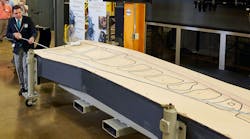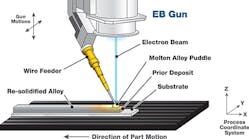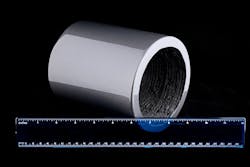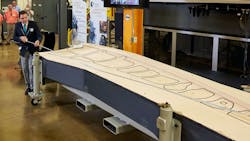Movies often portray technology in a cool or sexy finished product that defies the laws of physics, but it seems like it’s just not as entertaining to show how the sausage is made. In the James Bond films, for example, gadgets seems to come about by magic courtesy of Q.
Some might think 3D printing is different, and it is cool. However, this article covers a few things happening behind the scenes that are allowing for a 3D-printed future. After all, tackling challenges such as cost, build space, and speed is necessary before James Bond can drive off in his cool 3D-printed sports car.
Economics
A new technology has little chance of survival if it costs more than what is currently being used. One reason a more expensive solution might be used is for speed. “If milling a part takes 20 minutes, molding it with a thermoset might take five minutes,” says Ron Hawley, chief science officer of Integrated Composite Products Inc (ICP). “Molding a part might not be necessary to save weight or cost, but it might may have been imperative to fill orders.”
However, 3D printing isn’t known for its speed. Over the years speeds have been improved, but most of the savings in 3D printing is in small, complex parts. Beyond this, designers are looking for parts that can be combined in a single print, or else to find value-added features that will offset the cost of switching to 3D printing.
Combining parts can be considered low-hanging fruit as a production line is now eliminating costs associated with assembly: labor, fasteners, etc. This combination of time and cost savings has moved 3D printing from prototyping into production for some applications. In addition, parts that require a lot of material removal from the bar stock might improve on costs in material savings using 3D printing.
Material Savings
“The average yield for a titanium component on an aircraft [made using traditional methods] is 10%,” notes Bill Peter, director of DOE’s Manufacturing Demonstration Facility located at Oak Ridge National Laboratory (ORNL). “For every 10 lb. of incoming titanium material, 9 lb. are removed, and 1 lb. ends up in the final component.”
Depending on the process used, 3D printing has waste. For example powder bed will have some titanium powder that is not solidified. While used powder can be recycled, it is often necessary to blend it with some virgin powder to ensure quality and material properties are maintained.
In other 3D processes, such as wire-fed 3D printing, there is almost no waste. In addition, the average 3D printing grade Titanium 6AI-4V powder is about 141% more expensive than the average cost of Titanium 6AI-4V wire. Also, Titanium wire generally has a faster turnaround time than Titanium powder (sometimes up four weeks), according to Sciaky Inc., a wire-fed 3D printing provider.
The Electron Beam Additive Manufacturing (EBAM) process, which is exclusive to Sciaky, Inc., utilizes wire feedstock and an electron beam heat source to produce a near-net shape part inside a vacuum chamber.
There are other materials that are being saved with 3D printing. For example, “While conventional sintered magnet manufacturing may result in material waste of as much as 30 to 50%, additive manufacturing will simply capture and reuse those materials with nearly zero waste,” said Parans Paranthaman, principal investigator and a group leader in ORNL’s Chemical Sciences Division. The project was funded by Department of Energy’s (DOE) Critical Materials Institute (CMI).
In 2016 Researchers at the DOE’s ORNL not only reduced waste material, but also were able to print permanent magnets with 3D printing that outperformed bonded magnets made using traditional techniques.
This isotropic, neodymium-iron-boron bonded permanent magnet was 3D-printed at DOE’s Manufacturing Demonstration Facility at Oak Ridge National Laboratory.
Not the Average Desktop Printer
that stated, “ORNL has worked with additive technologies for years, but only recently has the lab put an intense focus on applying its scientific expertise to some of additive manufacturing’s largest challenges,” writes Leo Williams.
“The challenges in additive manufacturing have changed,” notes Ryan Dehoff, leader of the lab’s Deposition Science and Technology Group. “Five years ago, the focus was on creating complex geometries. Today additive processes are required to be faster, larger, and use an increased range of materials.”
Build Space
ORNL is known for its large 3D printing abilities. It has printed several cars and living spaces, and holds the Guinness World Record for the largest solid 3D-printed item. One key to printing large is to take advantage of robotic arm, and then increase its reach with a gantry system.
Official measurement of the 3D-printed trim tool co-developed by Oak Ridge National Laboratory and The Boeing Company exceeded the required minimum size to achieve the Guinness World Records title of largest solid 3D-printed item.
Using robotic arms on a gantry system, ORNL researchers have expanded the build space of 3D printing, deposited material faster, and maintained print quality. “One of the problems we have with traditional gantry systems is that when you’re growing a part, you can’t defy gravity,” explains Lonnie Love, leader of ORNL’s Manufacturing Systems Research Group. “One thing I can do with a robot is tilt the part or apply pressure. If you look at how humans make clay pots, you defy gravity all the time by supporting the material while it’s being formed. Again, imagine having multiple robots that can support the material while it’s setting, and then when it’s stiff enough they can let it go.
“When you want to make something massive, you want this robot to be on a rail,” he continues. “Imagine a robot that’s on a moving base that can move forward, backward, side to side, up and down. Now you’re not limited in terms of the size of part you want to make.”
Speed
Now that the build space is increased, the speed becomes a limiting factor. The speed increases cost. Love notes that between the cost of materials going into the process, the cost of the machine itself, and the slow pace of printing, parts coming off a conventional 3D printer end up costing as much as $1,000 a pound. Few industries can support such a cost, with aerospace and medical applications being potential exceptions.
“There’s a fundamental limit on how fast you can heat the wire and melt it,” Love explains. “By going from a heated tube and wire [plastic filament] to a pellet and screw, you go from a limit of one cubic inch an hour to printing as fast as you want.”
By using this new system and reinforcing the material with carbon fiber, he says, researchers were able to bring the cost of a new part from $1,000 a pound to around $20 a pound.
3D Printing, Manufacturing, and Employment
As 3D printing reduces cost, build space, and speed, it is disrupting indirect production areas. For example, simple hand tools, fixtures, and gages can be 3D printed on sight, for a fraction of the time and cost. Volkswagen started using a low-cost plastic extrusion printer for employees to have custom tooling to help production. The printers made tooling onsite in hours. In some examples, printing in-house saved weeks.
From left to right: Additively manufactured pattern, pattern mounted in casting box, sand pull test from AM patter, and final part from casting. (Courtesy: ORNL)
Indirect processes like molding are also catching on. Molds are time consuming, and there may be more iterations before the final mold goes into production. This has given manufacturers flexibility, which is another large consideration that will continue to make 3D printing a disruptive force.
3D printing bring the ability to change the way we things of modern manufacturing. Today we have large factories with shipping and logistics that has a centralized manufacturing model. 3D printing allows for a decentralized method.
Ing, the bank and financial service corporation, predicts that printing could cut trade between countries by 40%: “For now it has very little effect on cross-border trade. This will change once high speed 3D printing makes mass production with 3D printers economically viable. The first technical steps have already been taken…3D printers use far less labor, reducing the need to import intermediate and final goods from low wage countries.”
While 3D printing is saving cost, materials, and shipping, it may usher in smaller or more local manufacturing that has the potential to increase jobs, diversify economies, and challenge the way we think of modern manufacturing.





